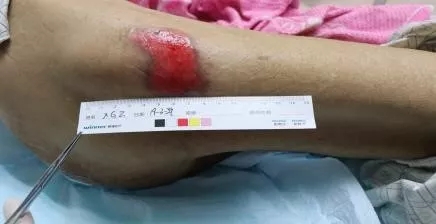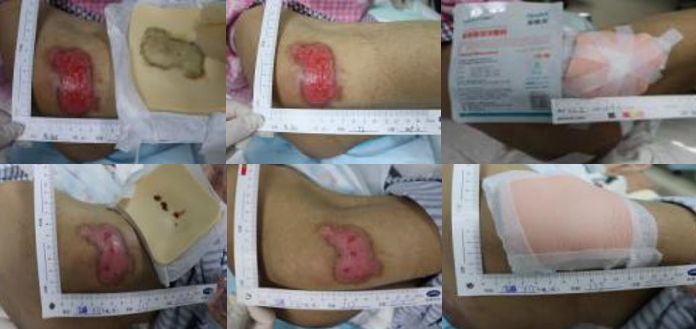A 72-year-old patient with weakness
of both lower limbs for more than two years had left lower limb muscle
strength of grade 2 and right lower limb muscle strength of grade 2+,
increased with enabling to walk. The patient was admitted to the
hospital with one pressure injury of stage 2 and one pressure injury of
stage 3. One of the pressure injuries reoccurred on the healed scar.
Diagnosis:
1) Demyelinating lesions of the brain (bilateral frontotemporal lobes and radiation crown)
2) Protein and calorie malnutrition
3) Lateral pressure injury of the right femur (stage 2)
The
gradual decline of the patient in muscle strength led to severe
limitation of activity and long-term compression of local skin, causing
the stress injury.
2. Therapeutic Schedule
In
this case, NAIFURUN was used for the treatment of stage 2 pressure
sore. Local skin pressure was reduced, and then foam dressing and
adhesive tape were applied for fixation after the drug change. The drug
was changed three times. The wound healed after 12 days of treatment.

3. Method of Use
After
washing with saline and absorbing the water, the double-layer foam
dressing and adhesive tape were applied for external fixation. The
inner-layer foam dressing was for absorbing exudate and the outer-layer
foam dressing was for decompression.
This
patient had pressure injuries in the sacrococcygeal and right greater
trochanter at the same time. The decubitus position was limited.
Therefore, we assisted the patient in controlling the position in order
to avoid the occurrence or development of new pressure injuries into the
stage 3.

Treatment Process
4. Clinical Experience
1)
The foam dressing is soft and breathable with a certain viscosity. It
is suitable for the wound with a small and medium amount of exudate and
the prevention of pressure injury.
2) Due to the softness of the
dressing, it is suitable for wounds on parts with large mobility like
joints. It can improve the compliance of the dressing and the wounds.
Polyurethane Foam Dressing